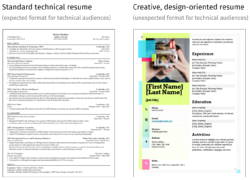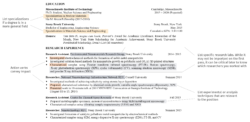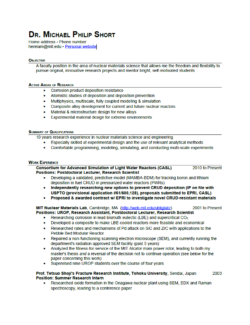Your resume is often the first impression you’ll make to a future employer. Recruiters only spend 6–10 seconds reviewing a resume at first, so it is vital to customize your resume to the specific application. Your goal is to highlight your qualifications and show specific, concrete, and concise evidence.
| Contents |
| 1. Before you start 1.1. Why this job/fellowship? Why you? 1.2. Who your audience? 1.3. Difference between resume and CV 2. What goes in a resume 2.1. Your relevant qualifications 2.2. Evidence for your qualifications 3. Maximize effectiveness 3.1. Use concrete, quantified evidence 3.2. Be concise 4. Quick tips and resources 5. Examples |
1. Before you start
Before anything else, take a moment to reflect on your career or academic trajectory. What are your goals (beyond this position)? What are the big challenges and successes you have had so far? Is it time for new goals?
1.1. Why this job/fellowship? Why you?
An effective CV/resume establishes that you are a qualified match so you’ll need to tailor your document to each position or program.
Are you a match? With your long-term goals in mind, consider why this job/fellowship is right for you, and why you are right for it. What type of work does the company do? What is their mission and does it overlap with what you care about? Create a list of what excites you about this opportunity.
Are you qualified? Your resume should convince the reader that you are qualified to take on the role you are applying for. Present your strengths through concrete experiences and accomplishments to prove your qualification.
1.2. Who is your audience?
There are typically two types of resume reviewers: human resource (HR) professionals and hiring managers. HR professionals will look for a match between resumes and the job posting requirements. For example, if the posting is looking for experience with a specific process, method, or software tool, you should highlight your matching experience. As for hiring managers or technical professionals, they will examine your experience and qualifications. These reviewers likely know your field well, so feel free to use field-specific jargon to communicate your qualifications.
 In engineering and technical fields, resume reviewers mostly expect a clear, simple format with headers: Education, Experience, Skills, etc. It can be tempting to adopt a “flashy” format that Microsoft Word or an online resource suggests, but do so with caution! Flashy formats can be distracting and obscure your qualifications. They may even suggest that you are naive about your field’s expectations.
In engineering and technical fields, resume reviewers mostly expect a clear, simple format with headers: Education, Experience, Skills, etc. It can be tempting to adopt a “flashy” format that Microsoft Word or an online resource suggests, but do so with caution! Flashy formats can be distracting and obscure your qualifications. They may even suggest that you are naive about your field’s expectations.
1.3 Difference between resume and CV
Although resumes and CVs serve the same general purpose, they hold key differences. A resume is commonly used for careers in business and industry, and is actually the condensed summary of a CV. A CV (short for curriculum vitae) is the long-form or full version of your resume, usually intended for academic or research positions. In this article, we say “resume” to mean “resume or CV,” except when we contrast the two.
| Resume | CV | |
| Goal | Shows how your experiences and skills qualify you for the target job | Shows your academic achievements and research qualifications |
| Length | Strict 2-page limit. Aim to keep it to 1-page unless you have a PhD or other significant, relevant experience. | 2-3 pages for a graduate student; gets longer through a career |
| Typical sections include… |
• Name & contact info • Education • Work experience • Skills • Awards and Honors |
• Name & contact info • Education • Research experience • Skills • Career objectives/research interests • Publications & presentations • Awards & grants • Professional societies • Teaching experience • References |
2. What goes in a resume
What belongs (or doesn’t) belong in a resume depends heavily on your audience. In some countries outside the US, it is expected to include a photograph of yourself and indicate your gender, marital status, number of children, religion, etc. Doing so for a US-based organization would be a faux-pas, so be aware of possible differences when applying internationally. Here, we’re assuming that you’re targeting a US-based audience.
2.1. Your relevant qualifications
Customize your resume to the position to convince the reader that you are a qualified match. For example, it requires different skills to “drive independent research” than to “work closely with an interdisciplinary team,” so you would list different qualifications for each. With the required qualifications from the job description in mind (along with anything else you know about the position), highlight skills and accomplishments in your resume that demonstrate your relevant qualifications. Do this by:
- Including research or professional experiences,
- Providing details (bullet points) for the most relevant experiences,
- Placing important experiences or skills earlier in the document.
2.2. Evidence for your qualifications
One phrase the Communication Lab often uses is, “show, don’t tell.” Instead of saying you are a great candidate, show the reader by providing evidence that you meet the qualifications. The evidence is in your experiences, awards, and impact in your academic/professional career.

If you are early in your education or career, you may think you don’t have “real” experience to back-up your qualifications. Reflect on your coursework, class projects, and extracurricular activities, and identify experiences that are evidence of your qualifications. Ask yourself: What was my specific contribution? What was done differently because I was there? This is also a great reason to make a Comm Lab appointment. We regularly help students brainstorm and we’d love to help you!
3. Maximize effectiveness
3.1. Use concrete, quantified evidence
Give concrete evidence that you are a qualified match for the organization and the specific job you are applying to. Concrete makes memorable so when possible, also try to quantify your experience. Here are a few examples:

When it’s accurate, use action verbs to illustrate impact as opposed to passive verbs that can make you sound like a bystander. Aim for verbs that are specific to the contribution you made. The MIT Career Advising and Professional Development website has a whole list. Here are a few examples:

While it is important to quantify your experience and use action verbs, be careful not to oversell your experience. Be honest about what you have accomplished. You will get asked about what is in your resume, so be sure you can speak knowledgeably about everything in it. Avoid using hyperbole to make your accomplishments seem more important than they really are; it will get you noticed, but likely for the wrong reasons.
3.2. Be concise
A first-pass review of a resume is only 6–10 seconds, so your resume should quickly convince readers that you are qualified. Your resume should catalog your important qualifications in a way that is concise, easy to read, and specific. All extraneous information is a distraction and should be removed!

It may be tempting to include all of your jobs, experiences, and honors on your resume. Fight this urge and only include what is important or relevant to the position you’re applying for. More is not necessarily better (do not list common software like Microsoft Word under Skills). The less information you include, the more weight will be given to what you do include.
4. Quick tips and resources
- Use section headers that group your experience in a way that demonstrate you’re qualified for the job. For example, if the job involves teaching or entrepreneurship, include a section that highlights your experience in these areas.
- Order your headers to prioritize sections that have experiences most relevant to the position.
- Use white space to make your resume easy to read. Use indentation and bullet points to partition information.
- Bold important words so the reader can quickly find the important content. Pick and choose which words you bold; too many bold-faced words will detract rather than highlight.
- Use jargon carefully so that different readers understand your resume. Jargon can be OK to the right audience (like concisely communicating your technical work to a hiring manager), but can easily confuse non-experts such as HR professionals or hiring managers outside of your research field.
- Proofread and spell check your document. A single mistake can be enough to get your resume placed in the “no” pile. Read your resume out loud and listen for mistakes, or better yet, have a detail-oriented person read it over for you.
- Check out templates on GitHub from the BE Communication Lab.
Finally, do not hit “Submit” until someone other than yourself has reviewed your resume.
- The Comm Fellows regularly help clients translate their experiences into concrete skills and clear qualifications, while staying accurate and relevant. In particular, the Fellows lean on their experience as nuclear researchers to enhance the technical content of the resumes that they review. Make an appointment today if you have a resume due soon or if you want to have an updated version “just in case.”
- MIT Career Advising & Professional Development (CAPD) has a ton of resources at your disposal. Be sure to check them out for additional support.
5. Examples
To get started or receive feedback on your resume, make an appointment with us. We’d love to help!




